This is the main tumblog of Silvie Kilgallon. I'm a conceptual artist and my work is largely influenced by my academic interests in classics, ancient history, translation, and philosophy of language. This blog details conceptual, casual and personal projects on which I am currently working. To see the Stitched Iliad project, please check out the Stitched Iliad blog below.
154 posts
Data Weave



Data Weave
Kickstarter from @notendo to make high quality woven textile garments with digital abstraction based on digital files:
Data Weave continues work I began in 2001 that reimagines contemporary digital culture through textile arts to create a continuum of traditional and modern art forms and technologies. Applying my process of color encoding binary data to textiles expands fiber art traditions and addresses current preservation challenges faced by digital media.
… Data Weave is a marriage of art forms to the extent that the Jacquard loom’s use of punch cards to weave intricate motifs inspired the use of punch cards for saving and executing programs in early computing. Data Weave extends traditions of embedding symbols in textiles to communicate information by applying my practice of color coding binaries to weaving. This process of encoding data with color produces intricately detailed, cascading motifs that are meant to be woven pixel to stitch. Each pixel represents bits of data showing how weaving can also be understood as pixel art. Furthermore, Data Weave simultaneously illustrates an alternate way of data preservation and a materialization of digital ephemera by tangibly elucidating data structures with color.
More Here
-
 sureinsunlight liked this · 1 year ago
sureinsunlight liked this · 1 year ago -
 fuckingdepressedshit liked this · 3 years ago
fuckingdepressedshit liked this · 3 years ago
More Posts from Theclassicistblog
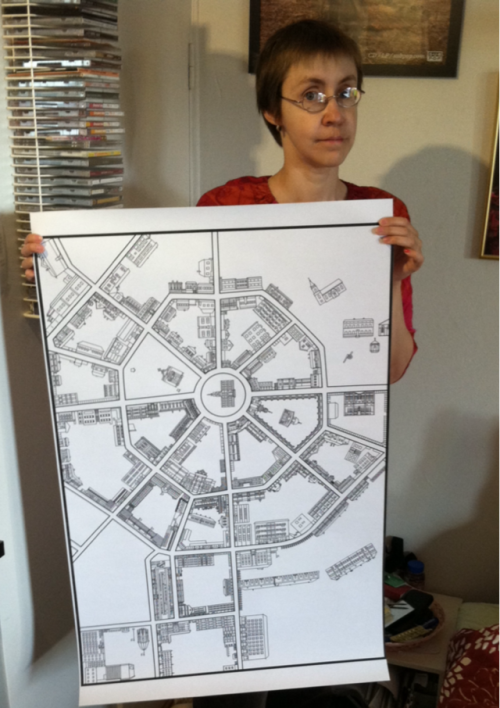
The city artist is ready. The invitation to color your feelings about your home town is extended to all the citizens.
And yes that is the layout of the Hamina city centre. The famed circular grid with city hall in the middle.
Hi, if I just started following you and you’re trying to figure out if I’m a bot or not: I’m not. I just use @aristoteliancomplacency for everything other than Artist Stuff™ now and haven’t done any Artist Stuff in a long while. One day.
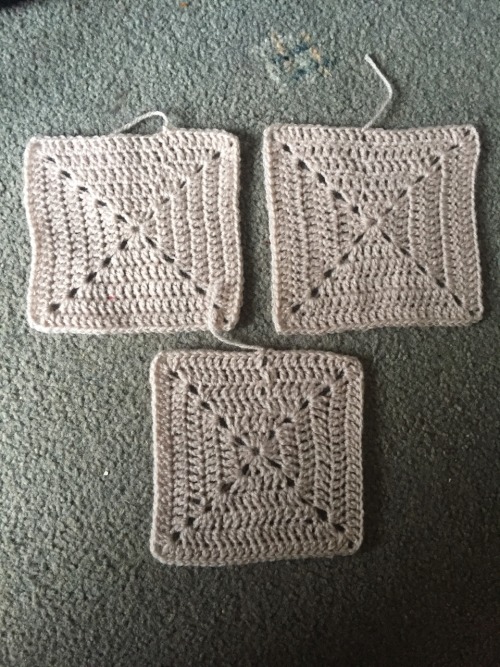
Potential solutions to the spiralling granny square problem (forgive the clumsy middle-of-the-row joins, I normally join in the corner, but I wanted to make sure that corner-joins weren't affecting what I was trying): As crocheters will know, any granny square of sufficient size will start to develop a spiral. How quickly it develops will vary based on tension and the particular signature of an individual crocheter, but the spiral is inevitable because of the fact that crochet stitches lean to the left. You can see it starting to develop on the top left square, most notably along the left side edge. One common solution is simply to turn the work after every round - that's what's happening in the top right square. Note the distinct absence of a spiral forming. The "problem" with this solution is that every other row has the "wrong side" of the stitch facing. But some might not consider this a problem at all - after all, this is what happens anyway when you're working rows rather than rounds. It will look best if you make sure you finish with a right side row, though, because working like this essentially creates a two-row repeat. So if your square has an odd number of rounds, this might bother you more. Another common solution is to block the work. Personally, I'm not a fan of blocking because the results vary so much based on what yarn you're using (the higher the natural fiber content, the better standard blocking will work. You can steam block fairly well for acrylic yarns). But blocking is always only a temporary solution: as soon as you wash the piece you have to repeat the blocking process. The solution I'm experimenting with now is the bottom one in the photo. A while ago I discovered that a friend of mine crochets wrapping the yarn what most would consider "the wrong way" (if it works for you, who cares?) I.e she wraps the yarn clockwise around the hook, whereas most people wrap anticlockwise (or counterclockwise). This means that both the right and the wrong side of the stitch look different to a piece producing the more common way, because it's not a total inversion of the common method - you're still inserting the hook from the front to the back of the stitch you're working into. However, if you totally invert the technique: wrap clockwise -and- insert the hook from the back to the front of the stitch, what you essentially produce is a right-side row, worked from the back, with the stitches slanting to the right. This solves the "wrong side row" problem and still gives you stitches that slant the other way to balance out the spiral problem. Interestingly, working this way seems to accentuate the spiral happening in each individual row/round, but still gives you a non-spiralling square. Problems with this technique: you're essentially learning a new stitch, and because you're wrapping the yarn a different way you're actually changing the amount of yarn involved in each yarn over. This means you're not only learning a new stitch, but have to hold your hook in a different way to try and adjust the length of yarn involved in a yarn over to match that of your normal stitches. Another problem: it makes the first stitch you work into after a corner really small and tight, and a bit of a fiddle to work into. As of yet, I don't know if the individual spiralling of each round would become less obvious if I was more practiced at the stitch. Another note: once you've worked the initial yarn over clockwise, inserted the hook the wrong way and pulled the loop through the stitch with a clockwise wrap, you can revert to the normal anticlockwise yarn overs for the rest of the stitch, and it'll still look good. This will help reduce some of the tension issues in constructing the stitch, but not that created by the initial yarn over. I have a few more ideas I haven't seen elsewhere that I still want to try, but I got impatient because I wanted to start another project (a crocheted Ancient Greek pithos) and I wanted to try out the ideas I had for that before I forgot them. The problem with experimentation is patience, and I don't always have it.
:D nice!
Yes, it was 2 stitches I missed, and: the missed out loop should be on the back of the work, if that makes sense.





Die Nase.
I’ve been writing fragmentary bits of pattern for a crochet face for years now, and finally put hook to yarn and made a prototype nose today.
Here are my “pattern” notes, which also function well to show why I don’t write patterns:
Dec, Dec, inc, inc, Dec Dec Inc inc Plain x 3 Inc inc Plain x3 Sl, ch2, dc2tog, ch2, sl Dc flt Sc3tog
The next challenges are figuring out eyes and lips, and then, of course, integrating them into one pattern. (Eye holes are easy enough, but sculpting the curves of eyelids a little harder).


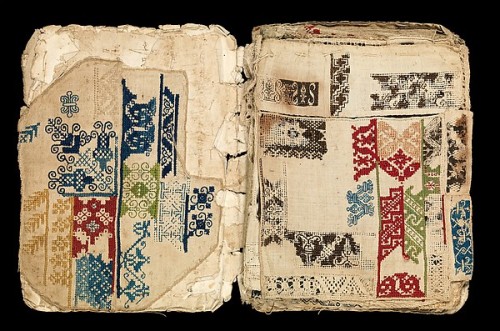
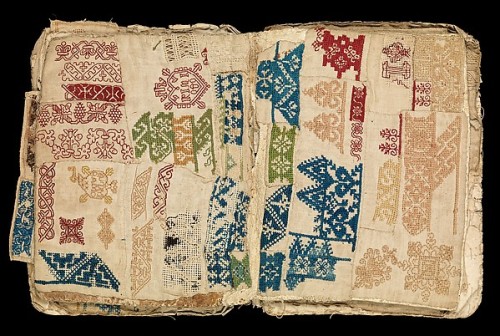
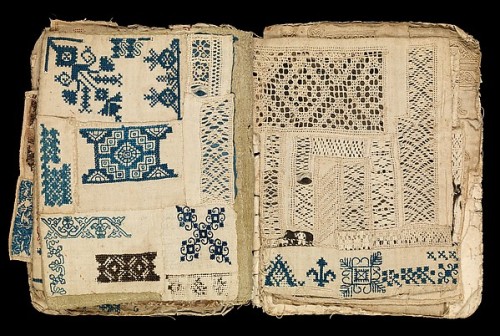
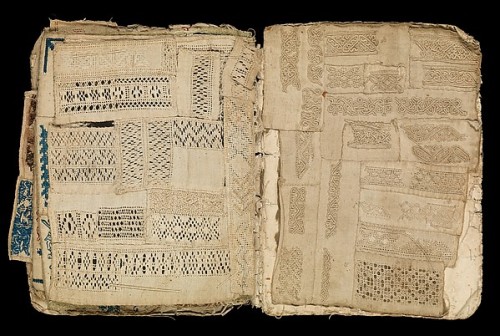
Booklet of embroidery and drawnwork (early 17th century). Probably Portugese. Linen, silk, leather, paper.
Images and text courtesy The Met.